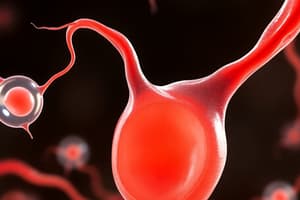Podcast
Questions and Answers
After ovulation, the remaining follicle becomes the ______, which secretes progesterone to prepare the uterus for implantation of a fertilized egg.
After ovulation, the remaining follicle becomes the ______, which secretes progesterone to prepare the uterus for implantation of a fertilized egg.
corpus luteum
Spermatogenesis starts with ______, undifferentiated cells located in the seminiferous tubules of the testes.
Spermatogenesis starts with ______, undifferentiated cells located in the seminiferous tubules of the testes.
spermatogonia
Primary spermatocytes undergo ______ I, dividing into secondary spermatocytes.
Primary spermatocytes undergo ______ I, dividing into secondary spermatocytes.
meiosis
Mature sperm are released into the ______ fluid during ejaculation, which occurs throughout adulthood in males.
Mature sperm are released into the ______ fluid during ejaculation, which occurs throughout adulthood in males.
In ______ gametogenesis, the laboratory recreation of the processes occurring naturally within the body is attempted.
In ______ gametogenesis, the laboratory recreation of the processes occurring naturally within the body is attempted.
In mammals, female gametes are produced through a process called ______.
In mammals, female gametes are produced through a process called ______.
Oogenesis starts during ______ development when primordial germ cells migrate from the yolk sac to the genital ridge.
Oogenesis starts during ______ development when primordial germ cells migrate from the yolk sac to the genital ridge.
Oocytes undergo meiosis, a process involving two rounds of nuclear division resulting in four ______ daughter cells.
Oocytes undergo meiosis, a process involving two rounds of nuclear division resulting in four ______ daughter cells.
Mature oocytes are released during ______, which occurs monthly in humans.
Mature oocytes are released during ______, which occurs monthly in humans.
As oocytes continue to grow, they are surrounded by layers of cells called ______.
As oocytes continue to grow, they are surrounded by layers of cells called ______.
Flashcards are hidden until you start studying
Study Notes
Gametogenesis: The Process of Producing Gametes
Overview
Gametogenesis refers to the biological process by which a germ cell undergoes meiosis to create haploid cells that eventually develop into gametes. In animals, meiosis is responsible for creating haploid cells that develop into sperm in males and ova in females. Understanding gametogenesis is crucial for understanding human reproduction, infertility, and evolution.
Female Gametogenesis: Oogenesis
Origin of Primordial Germ Cells (PGC)
In mammals, female gametes are produced through a process called oogenesis. Oogenesis starts during fetal development when primordial germ cells (PGCs) migrate from the yolk sac to the genital ridge to form the ovary. PGCs undergo mitosis to increase their numbers and differentiate into oocytes.
Development of Oocytes
Oocytes undergo meiosis, a process involving two rounds of nuclear division resulting in four haploid daughter cells. However, only one of these cells completes its maturation to become an oocyte, while the others degenerate.
Follicular Development
As oocytes continue to grow, they are surrounded by layers of cells called follicles. The outermost layer is the cortex, followed by the granulosum, theca, and finally the corpus luteum.
Release of Mature Oocytes
Mature oocytes are released during ovulation, which occurs monthly in humans. After ovulation, the remaining follicle becomes the corpus luteum, which secretes progesterone to prepare the uterus for implantation of a fertilized egg.
Male Gametogenesis: Spermatogenesis
Origin of Spermatogonia
Male gametes are produced through spermatogenesis. Spermatogenesis starts with spermatogonia, undifferentiated cells located in the seminiferous tubules of the testes. Spermatogonia undergo mitosis to produce two identical cells: one remains as a reserve cell, and the other differentiates into primary spermatocytes.
Meiosis in Spermatogenesis
Primary spermatocytes undergo meiosis I, dividing into secondary spermatocytes. Meiosis II follows, producing four haploid cells called spermatids. These spermatids then undergo a remodeling process called spermiogenesis, during which they develop into mature sperm.
Release of Mature Sperm
Mature sperm are released into the seminal fluid during ejaculation, which occurs throughout adulthood in males.
Role of Gametogenesis in Human Reproduction and Evolution
Gametogenesis plays a crucial role in human reproduction, leading to the formation of haploid cells that eventually develop into gametes. Understanding the mechanisms and pathways involved in cell germ cell specification, formation, and differentiation is essential for understanding human reproduction, infertility, and evolution.
In Vitro Gametogenesis
In vitro gametogenesis refers to the laboratory recreation of the processes occurring naturally within the body. While progress has been made in generating human germ cells using pluripotent stem cells, challenges remain. Strategies based on mouse models have revealed much about human germ cell development, but further research is needed to overcome limitations such as time-consuming culture systems and limited availability of ovarian tissues.
In conclusion, gametogenesis is a complex yet crucial biological process responsible for producing haploid cells that develop into mature gametes in animals. Understanding the mechanisms involved is essential for human reproduction, infertility, and evolution. While progress has been made in vitro, further research is needed to fully recapitulate this process in laboratory settings.
Studying That Suits You
Use AI to generate personalized quizzes and flashcards to suit your learning preferences.




